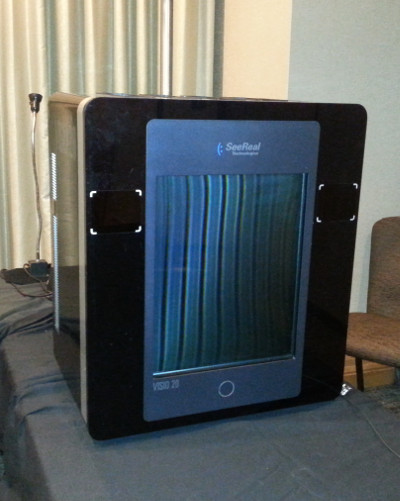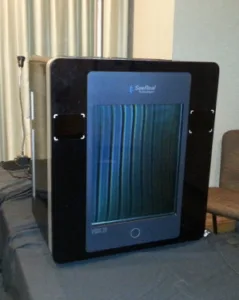The end game for most display enthusiasts is an electronic holographic display that provides no-glasses 3D viewing with high resolution and vertical and horizontal parallax. In other words – a display that is so good you might not be sure if it is real or not.
The path to a true electronic holographic display (not just something marketed as one) will be long. The bigger image you want, the more pixels and processing power you needed. Want to increase the depth and field of view? These multiply too, creating a pixel and processing nightmare that is beyond current technology. That’s why most demos have been tiny images with limited depth and field of view.
SeeReal hopes to break this paradigm with a different approach. It is using eye-tracking to determine from where you are looking at the image and what perspective can be seen. Then, it only renders those views – not the entire hologram which has been the approach to date. Using current display technology this limits the approach to a single user, but there are plenty of needs for such a display. Faster versions of the required custom displays will enable multiple users.
At SID, we had a chance to see a last generation prototype of its display (photo) – the latest version is not portable and resides in the company’s lab in Dresden. I will describe this one. Although the demo I saw did not have all of the latest components integrated, it was an awesome display nonetheless.

I actually described the new backlight in a companion article (Fraunhofer FEP Coatings Enable Efficient Laser Beam Expander for Holographic Displays). This features a laser that is beam expanded in two directions inside a lightguide to create a collimated light source. This illuminates the LCD panel assembly.
This assembly consists of four LCD panels with very special properties. The demo at SID was hosted in a suite by Merck as it wanted to showcase its expertise in developing the liquid crystal materials for this assembly (such as very high retardation materials).
The first two LCD panels perform amplitude and phase modulation as separate operations. Controlling these parameters is how the wavefront of the hologram is created. This requires very precise uniformity and control.
The second two LCDs are then used to steer the wavefront up or down and left or right – depending upon where the eye tracking algorithms determines the user’s eyes are located. SeeReal’s Hagen Stolle explained that these are kind of “light crossed louvers with a 2 micron pitch!”
A fairly standard infrared system illuminates the user and algorithms can acquire and track the eyes.

This approach reduces the computation load to calculate the hologram in real time by orders of magnitude. In addition, current LCDs with high density pixel pitches can now be used. The entire display is still filled up with data – not just a portion, which means many more pixels can now be devoted to resolution, depth of field and field of view.
The result was stunning. Once I sat down and the camera acquired my eyes, I was able to see a comfortable 3D image produced by the 20” monitor. Moving my head left and right and up and down produced new views in real time with no apparent lag or artifacts. I could even move an object within this volume interactively using a 3D mouse, bringing it to within a couple of feet (60cm) of my face with no eye strain and send it back maybe 20 feet (6m). That’s incredible. And this is the two-year old model!
All I can say is – I want to go to Dresden.

